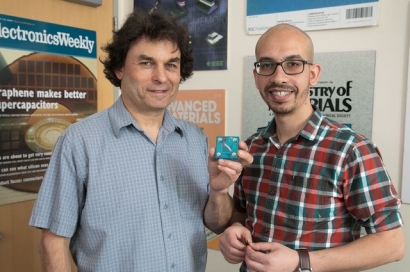
Their device has the potential to make hydrogen cars more affordable because it produces hydrogen using nickel, iron, and cobalt — elements that are much more abundant and less expensive than precious metals currently used to produce the fuel.
“Hydrogen is a great fuel for vehicles: It is the cleanest fuel known, it’s cheap and it puts no pollutants into the air — just water,” said Richard Kaner, the study’s senior author and a UCLA distinguished professor of chemistry and biochemistry, and of materials science and engineering. “And this could dramatically lower the cost of hydrogen cars.”
The technology, described in a paper in the journal Energy Storage Materials, could be especially useful in rural areas, or to military units serving in remote locations.
“People need fuel to run their vehicles and electricity to run their devices,” Kaner said. “Now you can make both electricity and fuel with a single device.”
Traditional hydrogen fuel cells and supercapacitors have two electrodes: one positive and one negative. The new device has a third electrode acting as both a supercapacitor for energy storage and a device for splitting water into hydrogen and oxygen. All three electrodes connect to a single solar cell which acts as the power source, and the electrical energy harvested by the solar cell is stored either electrochemically in the supercapacitor or chemically as hydrogen.
The researchers designed their electrodes at the nanoscale — thousands of times thinner than the thickness of a human hair — to ensure the greatest surface area would be exposed to water, which increases the amount of hydrogen the device can produce and also stores more charge in the supercapacitor. Although the device the researchers made would fit in the palm of your hand, Kaner said it would be possible to make larger versions because the components are inexpensive.
The new device is a step forward in that it produces hydrogen fuel in an environmentally friendly way. “Hydrogen energy is not ‘green’ unless it is produced from renewable sources,” said Maher El-Kady, a UCLA postdoctoral researcher and a co-author of the research. He added the new device could eventually replace the current method for hydrogen creation which relies on fossil fuels.
The paper’s other co-authors are graduate student Yasin Shabangoli and postdoctoral scholars Abolhassan Noori and Mohammad Rahmanifar, all of Tarbiat Modares.
Photo: Richard Kaner and Maher El-Kady with a replica of a new device that can use solar power to inexpensively and efficiently create and store energy.( Reed Hutchinson UCLA)

